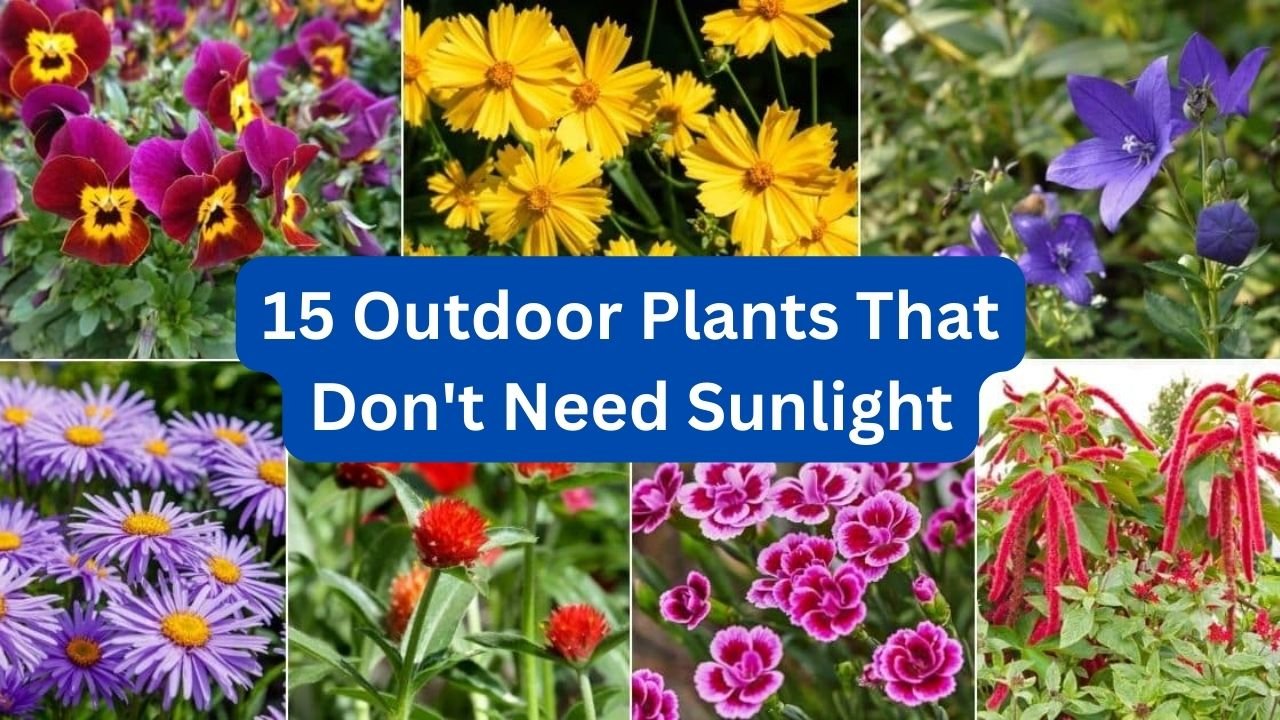Some plants may not need direct sunshine. Many annuals, perennials, and tropical plants may actually flourish in the shadow. These shade-loving blooming plants gladly flourish where their full-sun counterparts won’t, whether you want to brighten up those dark nooks in your yard or liven up a space under the shadow of a giant tree.

1 . Ajuga
Ajuga (Ajuga reptans) is a hardy perennial groundcover with vivid green, bronze, or tricolour leaves and in spring it throws up spikes of blue, purple, or white flowers if you’re looking to add colour to your shade garden with both flowers and foliage. This plant may provide an eye-catching show in pots when it is in bloom. Additionally, because ajuga spreads easily, it is advisable to keep it in containers or other small areas away from lawns.
Full sun to partial shade with equally wet, well-drained soil are the ideal growing conditions.
Height: up to 9 inches
Zones: 3-10
Ten Low-Maintenance Groundcovers for Shade
2 . Hosta
Among the greatest plants for shaded environments are hostas. Their leaves vary in a range of sizes, colours, and forms, so you can combine them with other shade plants and each other to make an eye-catching display. From June through autumn, several hosta cultivars also produce eye-catching white or lavender blooms.
Growing conditions include equally wet, well-drained soil in partial to full shade.
Height: up to three feet
Zones: 4-9
3 . Astilbe
Without astilbe, no shadow garden is complete. These hardy, long-blooming perennials give you a summer’s worth of fluffy flower heads and thrive in wet shade. The mounded, fern-like foliage of the plants is quite attractive, even when they are not in flower. The white, red, pink, orange, and violet astilbe blossoms are often first seen in late spring and early summer.
Growing conditions include equally wet, well-drained soil in partial to full shade.
Height: up to 18 inches
Zones: 3-8
Perennials with Long Blooms for Sun and Shade
4 . Impatiens walleriana
Impatiens (Impatiens walleriana), a favourite flower for shaded areas, can turn any gloomy nook into a floral carnival. Impatiens are a popular summer groundcover used by many gardeners for difficult-to-plant areas beneath towering trees. Available in white, pink, peach, yellow, orange, lavender, and bicolor blooms, single-flowering and double-flowering variants are also available. Impatiens thrive in containers as well. Change to New Guinea impatiens or wax begonias if downy mildew disease outbreaks have plagued your garden. These plants are resistant to the disease.
Growing conditions include equally wet, well-drained soil in partial to full shade.
Height: up to 2 feet
Zones: 10-11
5 . New Guinea Impatiens
Impatiens hawkeri, often known as New Guinea impatiens, is an essential annual plant for your shade garden due to its large, vibrant blooms. Compared to when they are planted directly in the garden, New Guinea impatiens seem to grow more in pots. However, grown any way, they brighten up the shadowy areas of your landscape with a tonne of magnificent colour. Pink, red, white, orange, lavender, and bicolor are some of the bloom colours. The leaves might be cream and green, dark green, or green with red veins. Although it is possible to cultivate New Guinea impatiens from seed, purchasing young plants from your neighbourhood garden centre in the spring is much simpler and quicker.
Partially in the shade in consistently wet, well-drained soil
Height: up to 4 feet
Zones: 10-11
6. Bleeding Heart
Giving your landscape a good dose of bleeding heart (Lamprocapnos spectabilis) can brighten the shadowy areas. These hardy perennials in the shade have beautiful, arching branches with small teardrop-shaped hearts as their blooms. Bleeding heart also produces gorgeous, ferny, blue-green foliage in addition to its stunning blooms. This low-maintenance plant hibernates in the middle to end of the summer and emerges the following spring.
Growing conditions include medium moisture and well-drained soil in partial to full shade.
Height: up to three feet
Zones: 3-9
7 . Wax Begonia
Wax begonia (Begonia semperflorens-cultorum), a shade plant that never fails, grows readily in your yard and requires very little upkeep. This mounded, compact plant is almost constantly in bloom, with clusters of white, pink, red, or bicolor flowers up until winter. It has thick, meaty stems and bronze or green leaves. Both borders and pots are ideal for the plants’ growth. There are various types with double flowers that are more flamboyant.
Full sun to partial shade with equally wet, well-drained soil are the ideal growing conditions.
Height: up to one foot
Zones: 10-11
8 . Fuchsia
Fuchsias don’t tolerate heat well, so they do best in cool, shaded environments; they aren’t a suitable option for hotter climes. In warm climes, several fuchsia species grow as tiny shrubs and can withstand Zones 7 and 8. Others are grown in hanging baskets with eye-catching, pendulous blossoms and are treated as annuals. Hummingbirds and butterflies like the plant’s protracted red, pink, white, violet, and purple flowers.
Growing conditions include equally wet, moisture-retentive soil in partial to full shade.
Height: up to 2 feet
Zones: 10-11
9 . Viola
A border garden in the shade filled with violas is always a joyful sight. When you approach, these cheerful spring bloomers—close relatives of pansies—almost seem to grin. During the cold seasons, violas appear to never run out of irresistibly cheery blossoms (they wither in the summer heat). Although colours might vary, the majority of cultivars have bicolor blooms in tones of lilac, yellow, orange, red, blue, purple, and white.
Partially in the shade in consistently wet, well-drained soil
Height: up to 9 inches
Zones: 5-8
10 . Wishbone Flower
Wishbone-shaped stamens are visible within the flowers of this shade plant, giving rise to its common name, Torenia fournieri, or “wishbone flower.” Throughout the summer, this tenacious plant puts on a stunning display of jewel-like trumpet-shaped blooms. In areas with warm climates, younger kinds will continue to bloom during the summer heat whereas older types will sulk in the heat. If necessary, remove the fading flowers to encourage new bloom.
Growing conditions include partial or complete shade, regularly wet soil, and good drainage.
Height: up to one foot
Zones: 10-11
11 . Leopard’s Bane
Leopard’s bane (Doronicum orientale), one of the aster family’s first perennials to bloom, emerges in early spring with vivid yellow daisy-like blooms. This enthusiastic perennial is a great partner for spring-blooming bulbs including tulip, daffodil, and scilla. Deadhead the plant’s spent blossoms to promote autumn blooming.
Growing conditions include a healthy, uniformly wet soil with full sun to some shade.
Height: up to 2 feet
Zones: 4-8
12 . Lungwort
Lungwort (Pulmonaria saccharata) has charmingly speckled or splotched leaves that you can count on to offer your garden an early burst of colour in the spring. Following the establishment of the leaves, the plants produce exquisite bell-shaped stalks with pink flowers that develop into baby blue hues, so you could find both pink and blue blooms on one stalk. This perennial will gently expand over your garden without becoming invasive since it is resistant to deer.
Growing conditions include equally wet, well-drained soil in partial to full shade.
Height: up to 18 inches
Zones: 3-8
13 . Coleus
Coleus must be mentioned in every article on vibrant shade plants. Until the first frost, this common foliage plant will brighten your shadow garden with its many leaf combinations. Occasionally, coleus may blossom, producing a short, blue spike in the late summer, but the plants thrive best when the spike is removed as soon as it occurs.
Growing conditions include wet soil and partial to full shade.
Height: up to three feet
Zones: 10-11
14 .Toad Lily
You may not anticipate much in the way of beauty from a plant with a name like toad lily (Tricyrtis hirta), yet in the late summer, this hardy perennial transforms into a prince by producing jewel-like white blossoms richly spotted with purple. The toad lily, which can bloom in complete shadow, can gradually naturalise a tiny area, covering it in a late-season burst of colour.
Height: up to three feet
Growing conditions include medium to heavy shade and moist yet well-drained soil.
Zones: 4-8
15 . Coral Bells
Some coral bell species (Heuchera spp.) have vibrant leaves that may brighten a shaded area in hues of scarlet, copper, green, plum, or chartreuse. Others have spectacular, bell-shaped blooms that bloom from late spring to early summer on long, pink, white, or red wands.
Full sun to partial shade with equally wet, well-drained soil are the ideal growing conditions.
Height: up to 18 inches
Zones: 3-8
16 . Hellebore
When you thought winter would never end, hellebores (Helleborus spp.) burst into bloom with their lovely blossoms. Hellebores, often known as Lenten roses, are among the very first perennials to bloom in the spring, sometimes even before the snow has melted. The majority of this practically unbreakable shade garden plant’s types produce flowers that face downward and are often white, pink, green, or purple. These blossoms are sometimes beautifully etched in a contrasting colour. The majority of types feature single flowers, however a few can have eye-catching double blossoms.
Growing conditions include humus-rich, well-drained soil and partial to complete shade.
Height: up to 18 inches
Zones: 4-9
17 . Heartleaf Brunnera
You can’t go wrong with heartleaf brunnera (Brunnera macrophylla), also known as Siberian bugloss and fake forget-me-not (because its blooms mimic those of real forget-me-not). It has vibrant flowers and leaves. This perennial grows clouds of tiny, vivid blue blooms in the spring on a pile of heart-shaped leaves. It goes well with springtime bulbs like tulips and daffodils. Even when the blooms have faded, you may still appreciate this plant’s lovely foliage all summer long; some types have silvery or variegated leaves that make gloomy nooks more cheerful.
Part shade and constantly wet, well-drained soil are the ideal growing conditions.
Height: up to one foot
Zones: 3-8

